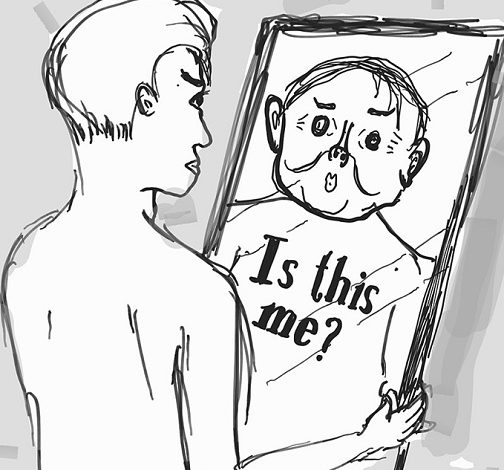What is body dysmorphia Symptoms characteristics and Treatment

Have you ever spent hours looking at yourself in the mirror and looking for defects or little things to fix, fix or correct? And soon after you asked yourself “Is this a disease”? How many times a day are you thinking about your flaws? Or rather, how often do you look at your qualities? Many people never stop to praise themselves or notice their victories. Is this a problem? In this article we will provide you the information about body dysmorphia.
Yes, this could be a result of a psychological disorder called Body Dysmorphic Disorder. Before imagining the worst, let’s understand a little more about? In this Psychology-Online article we will find out what body dysmorphia is.
Body Dysmorphic Disorder
Body dysmorphia , image disorder, or body image disorder are other terms used to refer to Body Dysmorphic Disorder and its characteristics. This disorder is characterized by a distorted and unrealistic view of one’s own body image.
Body Dysmorphic Disorder has another well-known name that was featured in the DSM-III which is dysmorphophobia. However, at that time it was part of Somatoform Disorders (Somatic Symptom Disorders), however, nowadays it falls within Obsessive Compulsive Disorder.
As the name implies, OCD is linked to obsession and compulsion – in search of “perfection” . Now, linking OCD with body dysmorphia, we have as an example:
An individual who persistently observes his photos before posting them, always finding several flaws and obsessively seeking to fix them in photo apps.
image disorder
The main feature of this disorder is the image disorder. The term “disorder” is used to refer to situations that cause discomfort. In this case, a very important factor for the perception of this problem is to see how much it affects the life of the individual and those close to him.
Vanity is different from a disorder. That is, it is not because the individual is vain or cares a lot about their skin or physical appearance that they have a problem linked to it.
The essential thing for us to know how to differentiate is how distressing the situation is for the person who suffers and the people who live with them. When there are a lot of negative feelings involved that start to affect day-to-day functioning, we may suspect an image disorder.
Symptoms of Body Dysmorphic Disorder
To identify if a person has body dysmorphia, it is important to check the following situations:
- Always exalting one’s own defects ;
- Distorted perception of body image;
- Perception of “imaginary” defects ;
- Symptoms affect personal, functional and professional life ;
- Always noticing the physical appearance ;
- Constantly searches for a “default” body ;
- It ignores or diminishes its own qualities.
If you have or know someone with these behaviors, be aware it is possible that the person or you are experiencing an image disorder or even Body Dysmorphic Disorder.
What characterizes a person with body dysmorphia
Dysmorphia is a broad concept that can be used in many ways. After all, the term is used as a way of talking about some deformity or pathology. Although the term is mostly used to refer to Body Dysmorphic Disorder.
image dysmorphia
In the literature review [1] it is suggested that individuals who suffer from body image disorder have a visually abnormal way of processing. That is, they cannot see the images as they really are.
“TDC subjects were slower and less accurate than controls. Taken together these results suggest abnormal global and local processing in TDC carriers.”
Dysmorphia with the body
Body dysmorphia is directly linked to image dysmorphia, after all, when you have “impaired” vision, you don’t see your own body in the right way. And it is precisely this impaired visual processing that is part of the process of Body Dysmorphic Disorder.
You will be seeing your body the wrong way and seeing defects in excess, diminishing your qualities, always seeking more and more. An example of this is people who suffer from anorexia or vigorexia.
Self-esteem and body dysmorphia
Although not the only factor, low self – esteem helps image and body dysmorphia. That is, people with lowered self-esteem or who were not taught about self-love have a greater tendency to body dysmorphia.
In addition, people who have a very strict factor with themselves also increase the chances of developing Body Dysmorphic Disorder.
Excessive rigidity creates perfectionist and potentially unattainable standards, reinforcing the individual’s impaired visual processing.
Treatment of body dysmorphia
The treatment of Body Dysmorphic Disorder has many controversies and few reviews in the literature to clarify.
But basically it consists of the use of anxiolytics in pharmacological intervention and psychotherapeutic interventions. The biggest and best results were achieved through Cognitive Behavioral Therapy. CBT is one of the first options in the treatment of disorders linked to OCD, so it is also best suited for body dysmorphia.
“We found four studies that evaluated the effectiveness of CBT…individuals with anxiety disorder in CBT improved symptoms of BDD that occurred in comorbidity”
With this quote, we can be aware that body dysmorphia does not only occur separately, it can also occur as a symptom of a generalized anxiety disorder , for example. So it is essential to treat the “base problem” and not just the symptoms of body dysmorphia.
In all treatment methods, decreasing the frequency of thoughts was fundamental to reduce anxiety in the face of image disorder.
Knowing this information, we can now have a better idea of what body dysmorphia is. If you suffer or know someone who goes through this, share and help in the pursuit of self-knowledge.